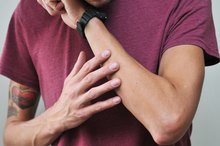Are Bumps on My Arms an Omega-3 Deficiency?
Omega-3 fatty acids are important for many aspects of human health, including memory, heart health, vision and proper functioning of the central nervous system. Omega-3 fatty acids cannot be made in the human body and must be ingested through foods such as fish or flaxseed. The upper limit of safety for omega-3 is 3 g per day. If you don’t consume enough of this important nutrient, you may experience side effects of a deficiency, including memory problems, mood swings and skin disorders.
Bumps
Small bumps on the backs of your arms may be a sign of an omega-3 deficiency. Other side effects of a deficiency include dry skin and patchy and cracking skin. Small bumps on the backs of your arms could be due to another reason entirely, such as keratosis pilaris, a skin condition in which tiny bumps form when keratin hardens around the hair follicles. The only way to know the exact cause is to consult with a physician.
- Small bumps on the backs of your arms may be a sign of an omega-3 deficiency.
Testing
Omega 3 Fatty Acids Overdose
Learn More
If you suspect that you are deficient in omega-3 fatty acids, ask your doctor to perform a simple blood test 2. The omega-3 index is the blood test that determines the amount of omega-3 fatty acids EPA and DHA in your red blood cells. However, not all doctors or laboratories offer this blood test. If you get the test, your doctor will review the results with you and determine the cause for the bumps on your arms.
- If you suspect that you are deficient in omega-3 fatty acids, ask your doctor to perform a simple blood test 2.
- If you get the test, your doctor will review the results with you and determine the cause for the bumps on your arms.
Omega-3 Supplementation
Omega-3 fatty acids are available in many supplements, including fish oil and krill oil. Your doctor can direct you to the right supplement for your situation. Omega-3 supplements will not only help treat the bumps on your arms if they are the result of a deficiency, but may also help with other conditions such as:
- high cholesterol
- high blood pressure
- cardiovascular disease
- diabetes
- rheumatoid arthritis
Omega-3 Foods
Is There Vitamin D in Omega 3?
Learn More
Incorporating foods rich in omega-3 fatty acids into your diet may supply your body with all of the omega-3 necessary for optimal health. The University of Maryland Medical Center and the American Heart Association recommend eating fish twice per week 1. Choose fish that are harvested from the wild for higher omega-3 content. Mixing flaxseed meal into yogurt, cereal and baked goods also helps provide extra omega-3s to prevent a deficiency.
- Incorporating foods rich in omega-3 fatty acids into your diet may supply your body with all of the omega-3 necessary for optimal health.
- Mixing flaxseed meal into yogurt, cereal and baked goods also helps provide extra omega-3s to prevent a deficiency.
Considerations
If the bumps on your arms do not resolve after you increase your omega-3 intake, consult with your doctor 2. Another blood test will determine if your omega-3 index has risen. If the bumps do not resolve, they could be related to a cause other than omega-3 deficiency.
Related Articles
References
Writer Bio
Amber Canaan has a medical background as a registered nurse in labor and delivery and pediatric oncology. She began her writing career in 2005, focusing on pregnancy and health. Canaan has a degree in science from the Cabarrus College of Health Sciences and owns her own wellness consulting business.









